Laminar Structure and Reservoir Quality of Shales with High Clay Mineral Content in the Qingshankou Formation, Songliao Basin
Abstract
:1. Introduction
2. Geological Setting
3. Experimental Samples and Methods
3.1. Fine Division of the Laminar Units
3.2. Key Experimental Analyses
4. Types and Characteristics of Lamina Units
4.1. Clay Mineral Laminar Unit (UA)
4.2. Clay Mineral–Ostracod Laminar Unit (UB)
4.3. Clay Mineral-Felsic Laminar Unit (UC)
5. Organic-Rich Shale Reservoir Characteristics
5.1. Reservoir Space of Different Laminar Unit
5.2. Reservoir Properties Evaluation of Different Laminar Units
5.2.1. Nitrogen Adsorption
5.2.2. D Pore Space Distribution
6. Discussion
6.1. Thermal Evolution Degree
6.2. Clay Mineral Transformations
6.3. Carbonate Cementation and Organic Acid Dissolution
6.4. Development Patterns of Different Laminar Units
7. Conclusions
- Three types of laminae are mainly developed in the high-clay shale of the Qingshankou Formation in Gulong Depression, Songliao basin. These include clay mineral lamina, Ostracod lamina, and felsic lamina. Among them, the Ostracod lamina can be divided into calcareous Ostracod lamina, pyrite Ostracod lamina, and Ostracod fragment lamina. Three kinds of laminar units are formed: UA (clay mineral lamina), UB (clay mineral–Ostracod lamina), and UC (clay mineral–felsic lamina).
- FE-SEM shows that the pore structures of different laminar units are significantly different. UA reservoir space is mainly composed of intergranular and intragranular pores of clay minerals, fractures, and organic pores. UB reservoir space is dominated by Ostracod shell margin sutures and intershell dissolved pores, pyrite intergranular pores, and chlorite intragranular pores; UC mainly develops intragranular pores of albite, chlorite and illite. The results of nitrogen adsorption, nano CT and FIB-SEM characterize the pore size distribution of different scales. It is found that UA mainly develops 15~20 nm slit-like pores, UB develops open wedge-shaped and curved slit-like pores, UC develops ink bottle-like pores with a fine diameter and wide body inside the felsic lamina, while parallel slit-like pores develop in the clay minerals.
- Comparing the 3D pore reconstruction images of different laminae and the porosity obtained by nano-CT, FIB-SEM, and NMR, it is found that the clay mineral laminae in the study area are the laminae with the highest porosity, and its specific pore volume, specific surface area, pore radius, and porosity are the best.
- Through the comparison of samples from different basins, it is found that the main reasons for the existence of physical differences between different laminae are the effects of the thermal evolution degree and diagenesis. At high maturity, the conversion of montmorillonite to illite in the UA increases the connectivity of pores within the clay mineral lamina. Meanwhile, the supply of organic acids in the UB and UC is insufficient, and the calcareous cementation tends to lead to pore blockage, resulting in 3~7 times more pore volume in the UA than in the UB and UC. In the future, we will conduct further research on shale with different maturity, and discuss in detail the difference between laminae caused by the effect of maturity on shale diagenesis evolution.
Author Contributions
Funding
Institutional Review Board Statement
Informed Consent Statement
Data Availability Statement
Conflicts of Interest
References
- Zou, C.; Yang, Z.; Cui, J.; Zhu, R.; Hou, L.; Tao, S.; Yuan, X.; Wu, S.; Lin, S.; Wang, L.; et al. Formation mechanism, geological characteristics and development strategy of nonmarine shale oil in China. Pet. Explor. Dev. 2013, 40, 14–26. [Google Scholar] [CrossRef]
- Sun, L. Gulong shale oil (preface). Pet. Geol. Oilfield Dev. Daqing 2020, 39, 1–7. [Google Scholar]
- Wang, Y.; Liang, J.; Zhang, J.; Zhao, B.; Zhao, Y.; Liu, X.; Xia, D. Resource potential and exploration direction of Gulong shale oil in Songliao Basin. Pet. Geol. Oilfield Dev. Daqing 2020, 39, 20–34. [Google Scholar]
- Lin, S.; Yuan, X.; Yang, Z. Comparative study on lacustrine shale and mudstone and its significance: A case from the 7th member of Yanchang Formation in the Ordos Basin. Oil Gas Geol. 2017, 38, 517–523. [Google Scholar]
- Jin, Z.; Wang, G.; Liu, G.; Gao, B.; Liu, Q.; Wang, H.; Liang, X.; Wang, R. Research progress and key scientific issues of continental shale oil in China. Acta Pet. Sin. 2021, 42, 15. [Google Scholar]
- Jarvie, D. Shale resource systems for oil and gas: Part 2—Shale-oilresource systems. In Shale Reservoirs—Giant Resources for the 21st Century: AAPG Memoir 97; Breyer, J.A., Ed.; The American Association of Petroleum Geologists: Tulsa, OK, USA, 2012; pp. 89–119. [Google Scholar]
- Yawar, Z.; Schieber, J. On the origin of silt laminae in laminated shales. Sediment. Geol. 2017, 360, 22–34. [Google Scholar] [CrossRef]
- Hua, G.; Wu, S.; Qiu, Z.; Jing, Z.; Xu, J.; Guan, M. Lamination Texture and Its Effect on Reservoir Properties: A Case Study of Longmaxi Shale, Sichuan Basin. Acta Sedimentol. Sin. 2021, 39, 16. [Google Scholar]
- Rokosh, D.; Pawlowicz, J.; Anderson, S.; Berhane, M.; Beaton, A. Shale fabric, mineralogy and effective porosity of the upper Colorado group. In Frontiers +Innovation; Alberta CSPG CSEG CWLS Convention: Calgary, AB, Canada, 2009; pp. 572–576. [Google Scholar]
- Sutton, S.; Ethridge, F.; Almon, W.; Dawson, W.; Edwards, K. Textural and sequence-stratigraphic controls on sealing capacity of Lower and Upper Cretaceous shales, Denver basin, Colorado. AAPG Bull. 2004, 88, 1185–1206. [Google Scholar] [CrossRef]
- Slatt, R.; O’Brien, N. Pore types in the Barnett and Woodford gas shales: Contribution to understanding gas storage and migration pathways in fine-grained rocks. AAPG Bull. 2011, 95, 2017–2030. [Google Scholar] [CrossRef]
- Brittenham, M. Geologic analysis of the upper Jurassic Haynesville shale in East Texas and West Louisiana: Discussion. AAPG Bull. 2013, 97, 525–528. [Google Scholar] [CrossRef]
- Huang, Z.; Liu, G.; Li, T.; Li, Y.; Yin, Y.; Wang, L. Characterization and control of mesopore structural heterogeneity for low thermal maturity shale: A case study of yanchang formation shale, ordos basin. Energy Fuels 2017, 31, 11569–11586. [Google Scholar] [CrossRef]
- Breyer, J.; Denne, R.; Kosanke, T.; Spaw, J.; Funk, J.; Christianson, P.; Bush, D.A.; Nelson, R.A. Facies, Fractures, Pressure and Production in the Eagle Ford Shale (Cretaceous) between the Maverick Basin and the San Marcos Arch, Texas, USA. In Proceedings of the Unconventional Resources Technology Conference, San Antonio, TX, USA, 1–3 August 2016. [Google Scholar]
- Zhao, K. Characteristics and Genesis of Carbonate Laminae in the Upper Es4-Es3 Lower Member of Dongying Sag, Bohai Bay Basin; China University of Geosciences: Wuhan, China, 2019. [Google Scholar]
- Xi, K.; Li, K.; Cao, Y.; Lin, M.; Niu, X.; Zhu, R.; Wei, X.; You, Y.; Liang, X.; Feng, S. Laminae combination and shale oil enrichment patterns of Chang 73 sub-member organic-rich shales in the Triassic Yanchang Formation, Ordos Basin, NW China. Pet. Explor. Dev. 2020, 47, 1342–1353. [Google Scholar] [CrossRef]
- Sun, L.; Liu, H.; He, W.; Li, G.; Zhang, S.; Zhu, R.; Jin, X.; Meng, S.; Jiang, H. An analysis of major scientific problems and research paths of Gulong shale oil in Daqing Oilfield, NE China. Pet. Explor. Dev. 2021, 48, 527–540. [Google Scholar] [CrossRef]
- Liu, B.; Shi, J.; Fu, X.; Lv, Y.; Sun, X.; Gong, L.; Bai, Y. Petrological characteristics and shale oil enrichment of lacustrine fine-grained sedimentary system: A case study of organic-rich shale in first member of Cretaceous Qingshankou Formation in Gulong Sag, Songliao Basin, NE China. Pet. Explor. Dev. 2018, 45, 828–838. [Google Scholar] [CrossRef]
- Wu, H.; Lin, T.; Bai, Y.; Zhang, J.; Liu, X.; Huo, Q.; Zhang, Y.; Li, J. Analyses of the mudstone (shale) oil exploration potential in North Songliao Basin. Pet. Geol. Oilfield Dev. Daqing 2019, 38, 78–86. [Google Scholar]
- Zhang, J.; Xu, X.; Bai, J.; Liu, W.; Chen, S.; Liu, C.; Li, Y. Enrichment and exploration of deep lacustrine shale oil in the first Member of Cretaceous Qingshankou Formation, southern Songliao Basin, NE China. Pet. Explor. Dev. 2020, 47, 637–652. [Google Scholar] [CrossRef]
- Subcommittee 3 on Geology Exploration of National Technical Committee 355 on Petroleum of Standardization Administration of China. In The Determination of Total Organic Carbon in Sedimentary Rocks; GB/T 19145-2003; China Quality and Standards Publishing&Media CO., Ltd.: Beijing, China, 2003; pp. 1–2.
- Subcommittee 3 on Geology Exploration of National Technical Committee 355 on Petroleum of Standardization Administration of China. In Rock Pyrolysis Analysis; GB/T 18602-2001; China Quality and Standards Publishing&Media CO., Ltd.: Beijing, China, 2002; pp. 1–5.
- Subcommittee 3 on Geology Exploration of National Technical Committee 355 on Petroleum of Standardization Administration of China. In Analysis Method for Clay Minerals and Ordinary Non-Clay Minerals in Sedimentary Rocks by the X-ray Diffraction; SY/T 5163-2010; Petroleum Industry Press: Beijing, China, 2010; pp. 1–43.
- Wu, S.; Lin, S.; Chao, D.; Zhai, X.; Wang, X.; Huang, X.; Xu, J. Fluid mobility evaluation based on pore structure investigation in tight sandstones: Case study of Upper Triassic Chang 6tight sandstones in Huaqing area, Ordos Basin. Nat. Gas Geosci. 2019, 30, 1222–1232. [Google Scholar]
- Subcommittee 3 on Geology Exploration of National Technical Committee 355 on Petroleum of Standardization Administration of China. In 3D Pore Structure Characterization of Rocks—Part 1: CT Scanning Method; SY/T7410.1-2018; Petroleum Industry Press: Beijing, China, 2010; pp. 1–43.
- Shan, C.; Zhang, T.; Guo, J.; Zhang, Z.; Yang, Y. Characterization of the micropore systems in high-rank coal reservoirs of the southern Sichuan Basin, China. AAPG (Am. Assoc. Pet. Geol.) Bull. 2015, 99, 2099–2119. [Google Scholar] [CrossRef]
- Aplin, A.C.; Macquaker, J. Mudstone diversity: Origin and implications for source, seal and reservoir properties in petroleum systems. AAPG Bull. 2011, 95, 2031–2059. [Google Scholar] [CrossRef]
- Wang, J.; Zhou, L.; Jin, J.; Liu, J.; Chen, J.; Jiang, H.; Zhang, B. Pore structure, hydrocarbon occurrence and their relationship with shale oil production in Lucaogou Formation of Jimsar Sag, Junggar Basin. Pet. Geol. Exp. 2021, 43, 941–948. [Google Scholar]
- Li, Y.; Cai, J. Effect of smectite illitization on shale gas occurrence in argillaceous source rocks. Pet. Geol. Exp. 2014, 36, 352–358. [Google Scholar]
- Morad, S. Carbonate Cementation in Sandstones||Calcite Cement in Shallow Marine Sandstones. In Growth Mechanisms and Geometry; Blackwell Science: Hoboken, NJ, USA, 1998. [Google Scholar] [CrossRef]
- Surdam, R.C.; Crossey, L.J.; Hagen, E.S.; Heasler, H.P. Organic-inorganic interactions and Sandstone diagenesis. Amer. Assoc. Pet. Geol. Bull. 1989, 73, 1–23. [Google Scholar]
- Bai, C.; Yu, B.; Liu, H.; Xie, Z.; Han, S.; Zhang, L.; Ye, R.; Ge, J. The genesis and evolution of carbonate minerals in shale oil formations from Dongying depression, Bohai Bay Basin, China. Int. J. Coal Geol. 2018, 189, 8–26. [Google Scholar] [CrossRef]
- Wang, M.; Chen, Y.; Song, G.; Steele-Macinnis, M.; Liu, Q.; Wang, X.; Zhang, X.; Zhao, Z.; Liu, W.; Zhang, H. Formation of bedding-parallel, fibrous calcite veins in laminated source rocks of the Eocene Dongying Depression: A growth model based on petrographic observations. Int. J. Coal Geol. 2018, 200, 18–35. [Google Scholar] [CrossRef]
- Aldega, L.; Carminati, E.; Scharf, A.; Mattern, F. Thermal maturity of the Hawasina units and origin of the Batinah Mélange (Oman Mountains): Insights from clay minerals. Mar. Pet. Geol. 2021, 133, 105316. [Google Scholar] [CrossRef]


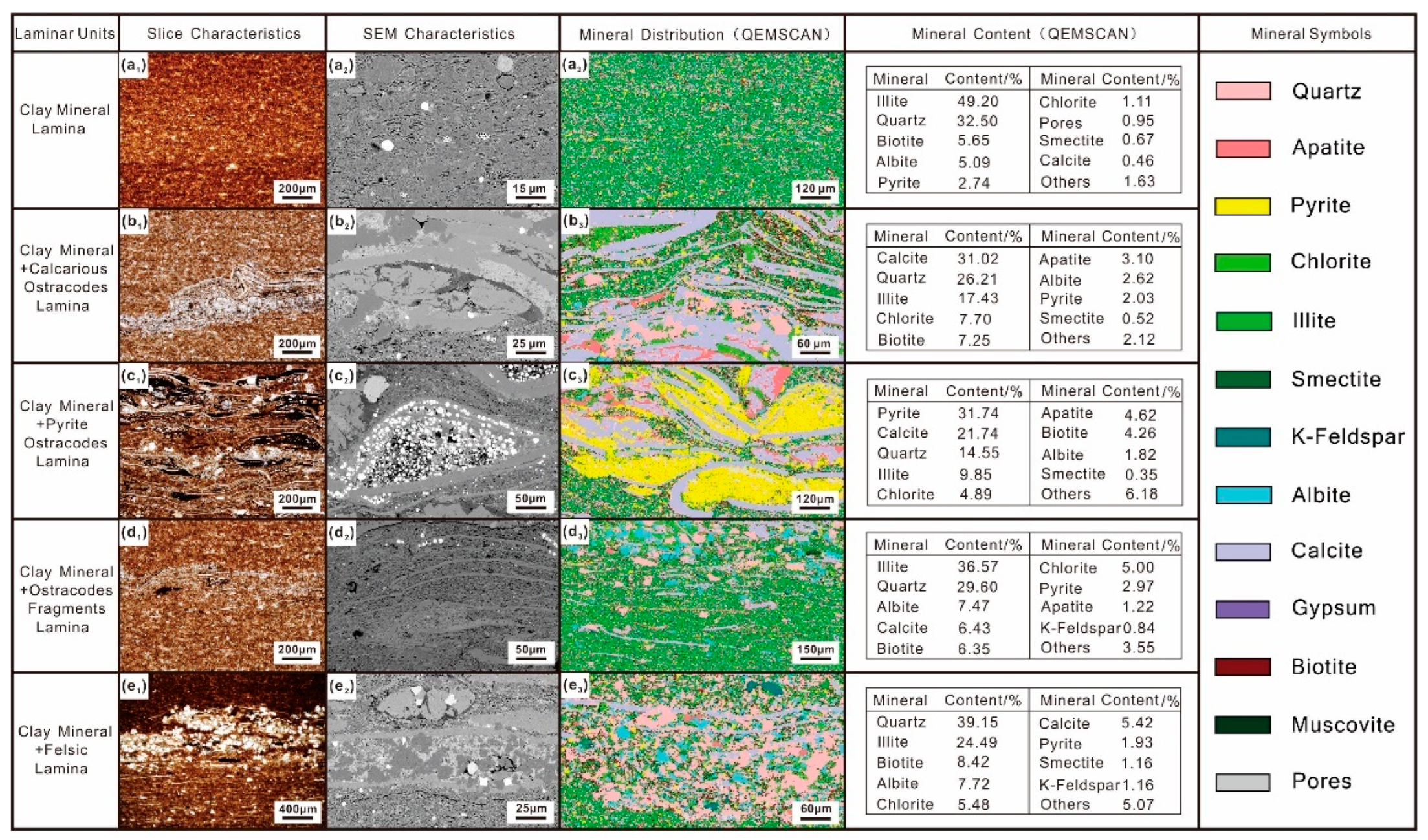
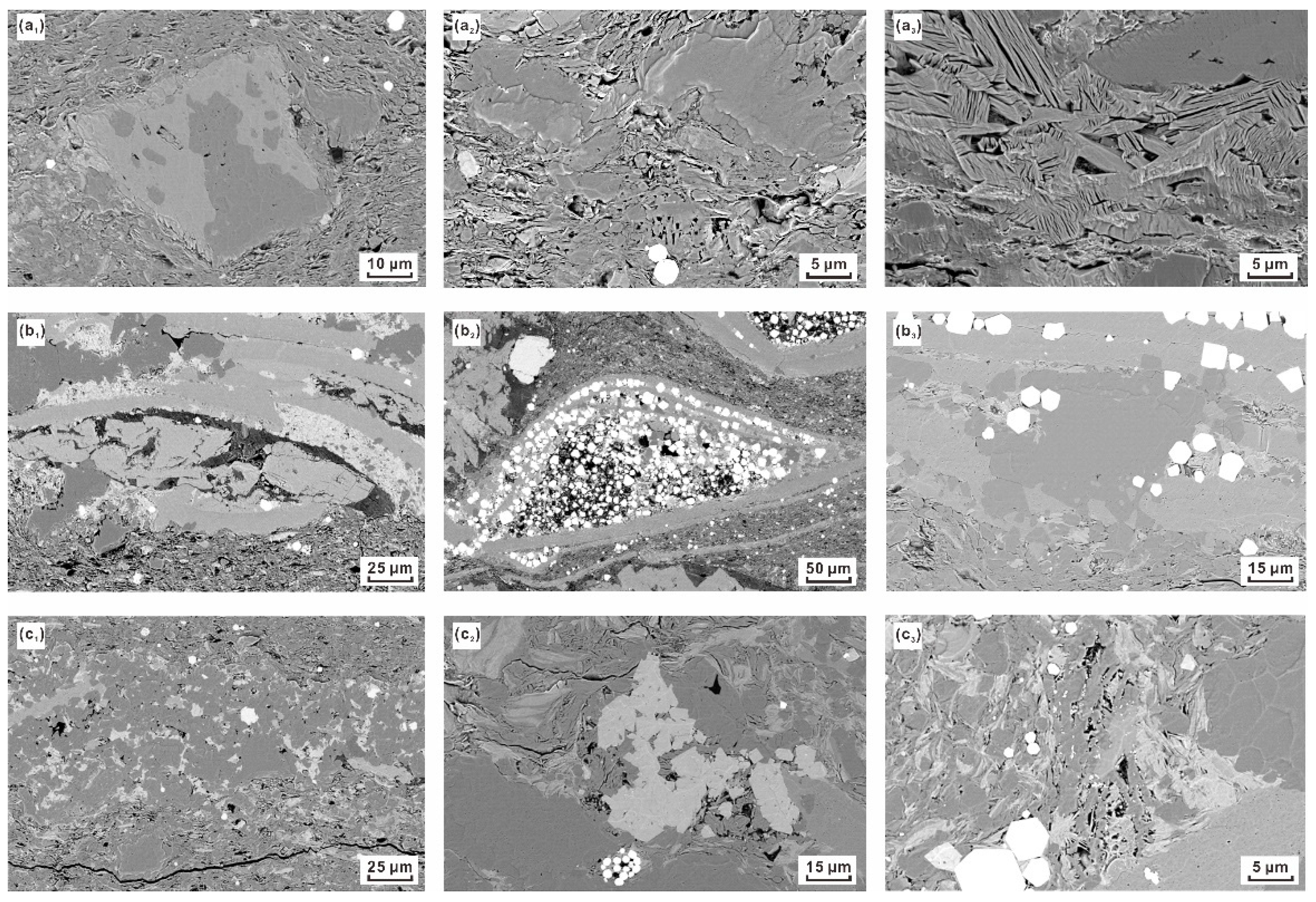
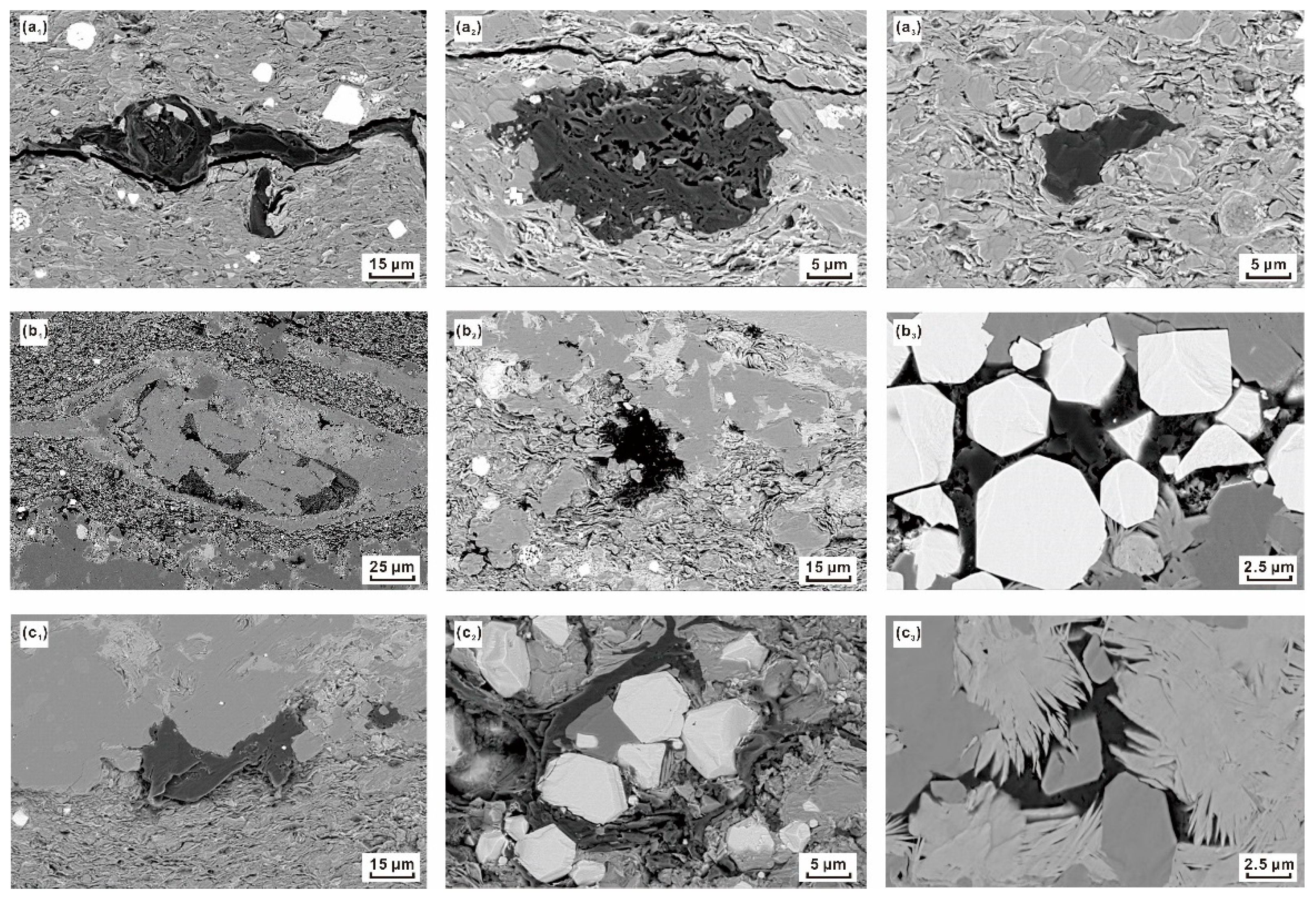

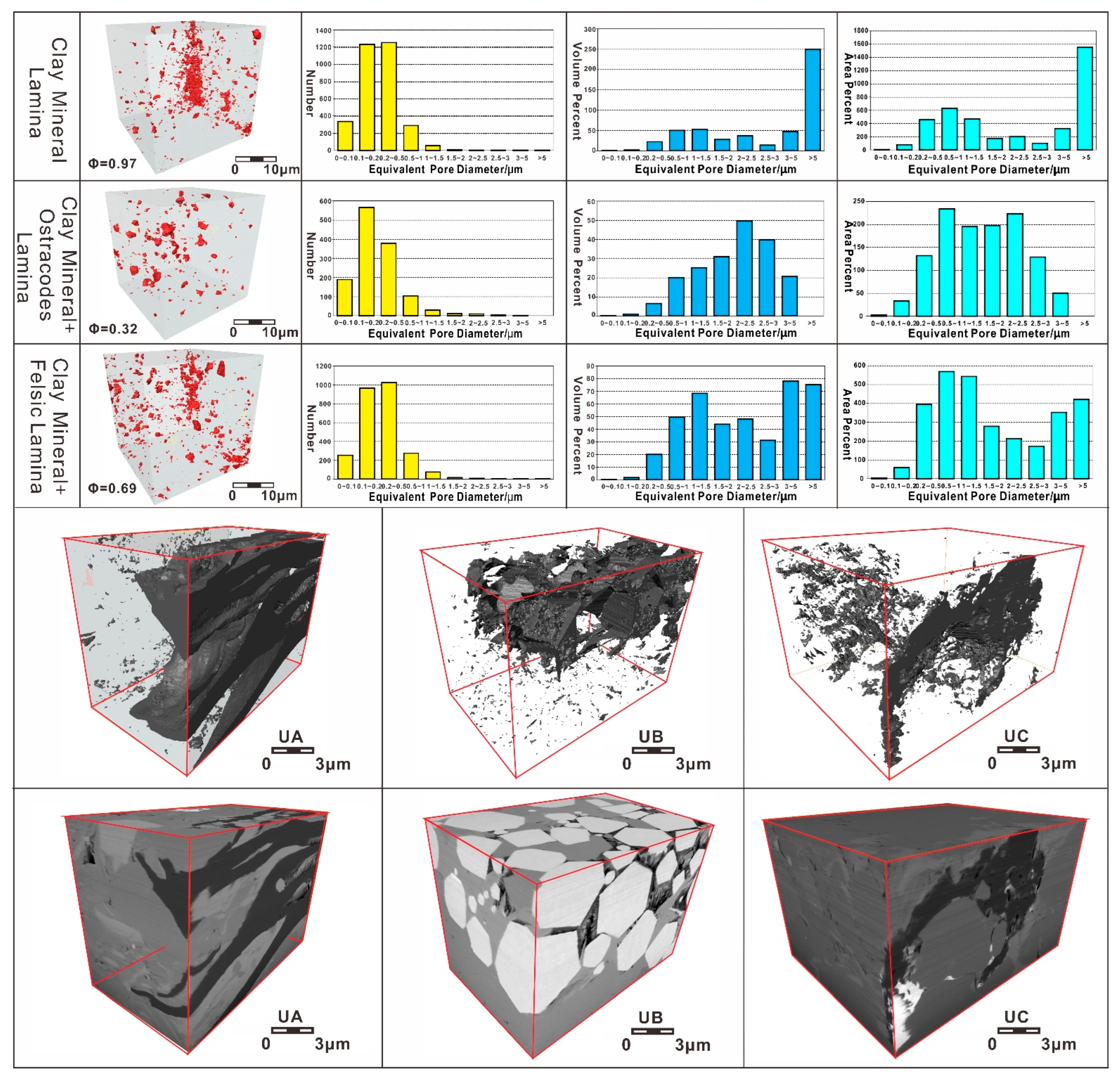

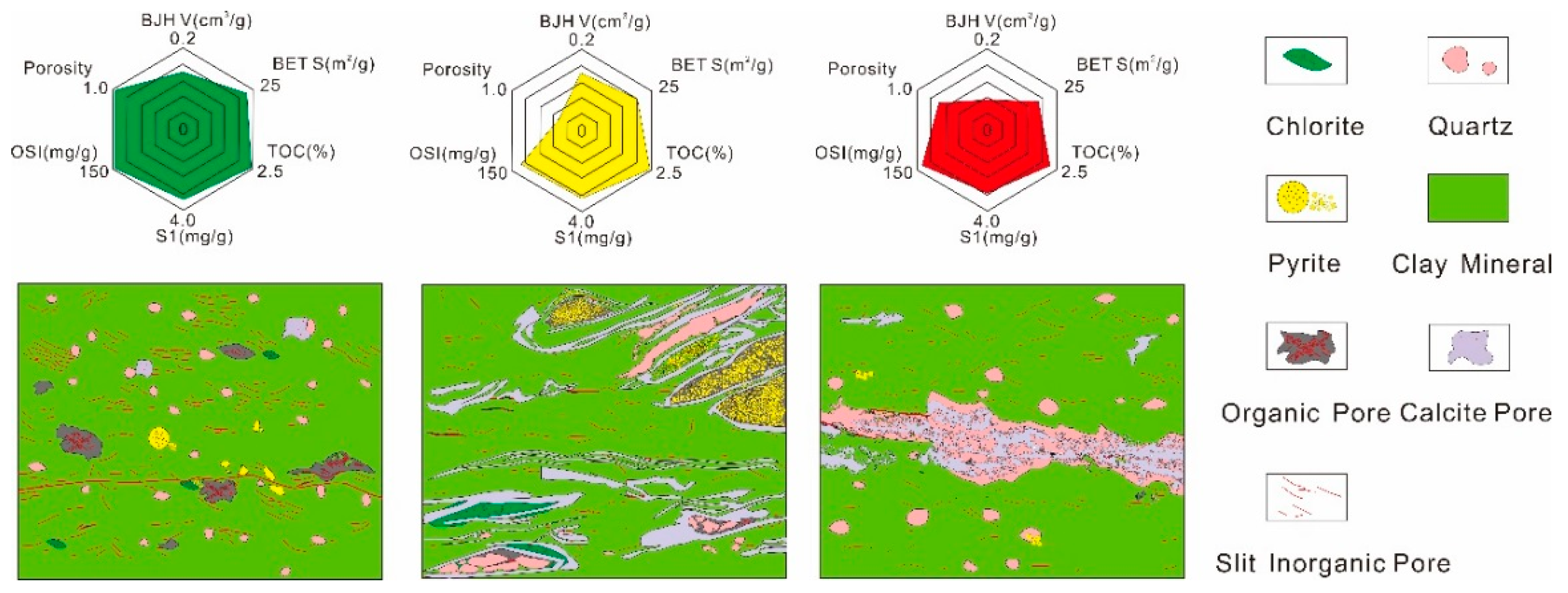
| Sample | Depth (m) | XRD Mineral Composition (%) | ROCK-EVALChemical Composition | Nitrogen Adsorption Experiment | Nano CT | NMR | FIB-SEM | ||||||||||
|---|---|---|---|---|---|---|---|---|---|---|---|---|---|---|---|---|---|
| Quartz | Feldspar | Calcite | Pyrite | Illite/Smectite Mixed Layer | Illite | Chlorite | TOC (%) | S1 (mg/g) | S2 (mg/g) | Average Diameter (Å) | BET Surface Area(m2/g) | BJH Pore Volume (cm3/g) | Porosity (%) | Porosity (%) | Porosity (%) | ||
| 1 | 2364.4000 | 36.2 | 7 | 1.8 | 3.8 | 17.92 | 29.184 | 4.096 | 2.30 | 3.02 | 3.73 | 182.7674 | 23.9111 | 0.109868 | |||
| 2 | 2364.4049 | 37.2 | 7 | 1.6 | 3.2 | 18.36 | 27.54 | 5.1 | 2.34 | 2.98 | 4.75 | 198.9769 | 24.8854 | 0.124393 | |||
| 3 | 2364.4099 | 33.2 | 6.5 | 2.3 | 4.4 | 20.368 | 28.408 | 4.824 | 2.34 | 3.23 | 2.96 | ||||||
| 4 | 2364.4110 | 32.7 | 5.6 | 2.5 | 5.1 | 18.935 | 31.378 | 3.787 | 2.11 | 2.70 | 2.47 | 192.1353 | 26.2548 | 0.126762 | 0.84 | 0.81 | 0.4 |
| 5 | 2364.4160 | 35.3 | 5.9 | 4.3 | 5.2 | 15.283 | 28.594 | 5.423 | 2.06 | 2.54 | 2.59 | ||||||
| 6 | 2364.4198 | 29.5 | 6.1 | 1.5 | 5.5 | 18.942 | 34.44 | 4.018 | 2.12 | 2.78 | 2.99 | ||||||
| 7 | 2364.4210 | 32 | 5.8 | 5.4 | 4.2 | 21.566 | 26.826 | 4.208 | 2.07 | 2.55 | 2.61 | ||||||
| 8 | 2364.4248 | 31.9 | 5.6 | 2.7 | 4.5 | 18.249 | 31.521 | 5.53 | 2.14 | 2.85 | 2.98 | ||||||
| 9 | 2364.4298 | 34.4 | 7.6 | 4 | 3.9 | 20.541 | 25.05 | 4.509 | 2.48 | 3.27 | 3.54 | 197.5474 | 20.9797 | 0.104142 | 0.32 | ||
| 10 | 2364.4300 | 32.7 | 6.9 | 3.1 | 2.8 | 20.71 | 29.975 | 3.815 | 2.40 | 3.46 | 3.47 | 191.2211 | 22.0494 | 0.105993 | 0.91 | ||
| 11 | 2364.4360 | 35.4 | 4.1 | 4 | 2 | 15.805 | 33.245 | 5.45 | 2.25 | 3.12 | 3.48 | ||||||
| 12 | 2364.4400 | 36.3 | 6 | 2.4 | 4.1 | 16.384 | 30.72 | 4.096 | 2.27 | 3.31 | 3.22 | 191.78 | 20.9594 | 0.101030 | |||
| 13 | 2364.4447 | 28.6 | 6.3 | 13.8 | 10.2 | 13.152 | 23.427 | 4.521 | 2.11 | 2.85 | 2.47 | 189.1186 | 19.2355 | 0.091492 | 0.85 | 0.83 | |
| 14 | 2364.4496 | 35.5 | 6 | 2.3 | 5 | 16.896 | 30.208 | 4.096 | 2.30 | 3.37 | 3.74 | ||||||
| 15 | 2364.4645 | 34.8 | 7.1 | 3.1 | 3.5 | 20.6 | 26.78 | 4.12 | 2.25 | 3.13 | 3.38 | 163.7265 | 17.9416 | 0.073773 | 0.69 | 0.94 | 0.31 |
| 16 | 2364.4745 | 33 | 6.5 | 1.8 | 3.9 | 17.536 | 33.428 | 3.836 | 2.47 | 3.57 | 3.51 | 183.1044 | 22.6552 | 0.104323 | 0.97 | ||
| 17 | 2364.4800 | 33.4 | 6.6 | 0.6 | 4.8 | 19.656 | 31.122 | 3.822 | 2.16 | 3.35 | 3.20 | 219.8406 | 17.8862 | 0.098721 | |||
| 18 | 2364.4850 | 32.6 | 7 | 0.8 | 4.5 | 13.775 | 36.366 | 4.959 | 2.02 | 3.10 | 3.03 | ||||||
| 19 | 2364.4943 | 31.4 | 6.3 | 0.9 | 4.6 | 21.584 | 31.808 | 3.408 | 2.14 | 2.98 | 3.11 | 0.11 | |||||
| 20 | 2364.5000 | 33 | 4.9 | 1 | 2.7 | 18.104 | 35.624 | 4.672 | 2.03 | 3.05 | 2.99 | 194.8713 | 21.4165 | 0.10485 | 0.82 | ||
| 21 | 2364.5043 | 29.3 | 6.6 | 3 | 4.2 | 21.053 | 31.295 | 4.552 | 1.99 | 2.88 | 2.66 | ||||||
| 22 | 2364.5070 | 26.2 | 7.5 | 9.7 | 7.7 | 16.626 | 27.873 | 4.401 | 1.88 | 2.80 | 2.64 | ||||||
| 23 | 2364.5092 | 32.4 | 6.8 | 1.5 | 4.3 | 17.6 | 33 | 4.4 | 1.87 | 2.72 | 2.35 | ||||||
| 24 | 2364.5110 | 35.8 | 7.6 | 2.5 | 6.1 | 14.88 | 29.76 | 3.36 | 1.90 | 2.60 | 2.72 | ||||||
| 25 | 2364.5192 | 31.5 | 6.5 | 2.9 | 5.4 | 18.795 | 31.146 | 3.759 | 2.12 | 3.02 | 2.96 | ||||||
| 26 | 2364.5260 | 33 | 7.6 | 1 | 6.7 | 16.027 | 33.088 | 2.585 | 1.96 | 2.92 | 3.14 | ||||||
| 27 | 2364.5300 | 28.9 | 6.2 | 2.4 | 6.4 | 20.196 | 33.099 | 2.805 | 1.97 | 2.84 | 2.91 | 171.5379 | 23.3542 | 0.100856 | 9.6 | ||
| 28 | 2364.5370 | 28.1 | 5.9 | 1.5 | 4.5 | 24 | 33 | 3 | 1.96 | 3.02 | 3.05 | ||||||
| 29 | 2364.5470 | 30.4 | 6.6 | 1.5 | 4.1 | 20.664 | 33.866 | 2.87 | 1.99 | 2.97 | 3.07 | ||||||
| 30 | 2364.5589 | 33.3 | 6.1 | 2 | 4.7 | 19.404 | 31.262 | 3.234 | 1.90 | 2.85 | 3.05 | ||||||
| 31 | 2364.5640 | 31.2 | 6.4 | 1.4 | 3.6 | 22.96 | 30.422 | 4.018 | 1.96 | 2.91 | 2.99 | ||||||
| 32 | 2364.5700 | 31.1 | 5.7 | 0.7 | 4.3 | 23.28 | 31.428 | 3.492 | 1.88 | 2.80 | 2.64 | ||||||
Publisher’s Note: MDPI stays neutral with regard to jurisdictional claims in published maps and institutional affiliations. |
© 2022 by the authors. Licensee MDPI, Basel, Switzerland. This article is an open access article distributed under the terms and conditions of the Creative Commons Attribution (CC BY) license (https://creativecommons.org/licenses/by/4.0/).
Share and Cite
Hua, G.; Wu, S.; Zhang, J.; Liu, R.; Guan, M.; Cai, Y.; Li, M.; Zhang, S. Laminar Structure and Reservoir Quality of Shales with High Clay Mineral Content in the Qingshankou Formation, Songliao Basin. Energies 2022, 15, 6132. https://doi.org/10.3390/en15176132
Hua G, Wu S, Zhang J, Liu R, Guan M, Cai Y, Li M, Zhang S. Laminar Structure and Reservoir Quality of Shales with High Clay Mineral Content in the Qingshankou Formation, Songliao Basin. Energies. 2022; 15(17):6132. https://doi.org/10.3390/en15176132
Chicago/Turabian StyleHua, Ganlin, Songtao Wu, Jinyou Zhang, Rongchang Liu, Modi Guan, Yi Cai, Mengying Li, and Surong Zhang. 2022. "Laminar Structure and Reservoir Quality of Shales with High Clay Mineral Content in the Qingshankou Formation, Songliao Basin" Energies 15, no. 17: 6132. https://doi.org/10.3390/en15176132






